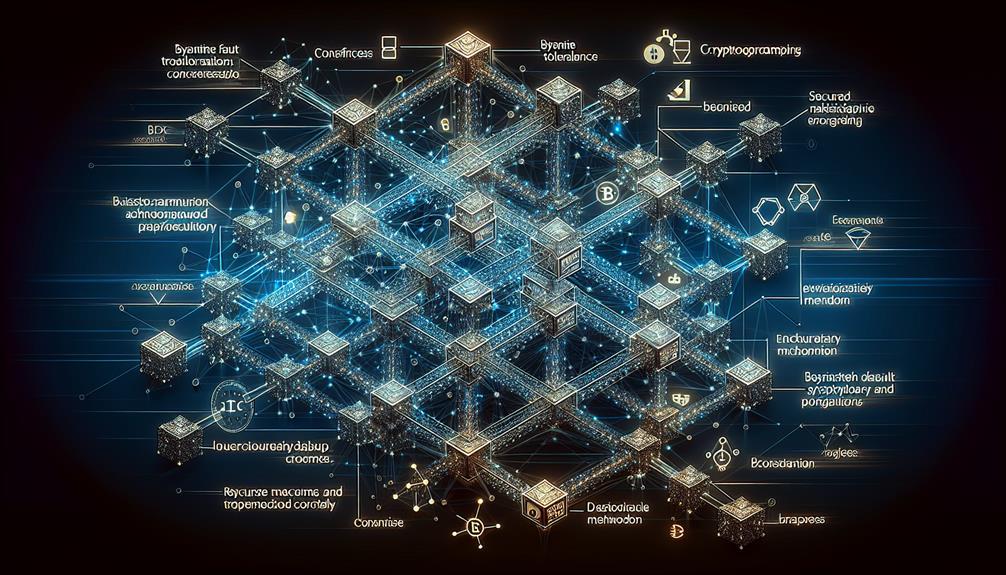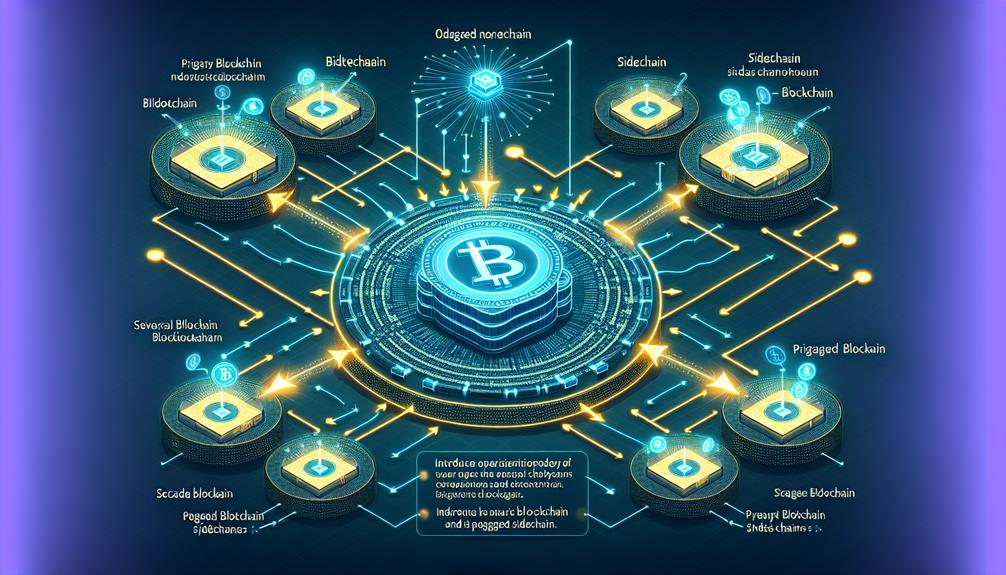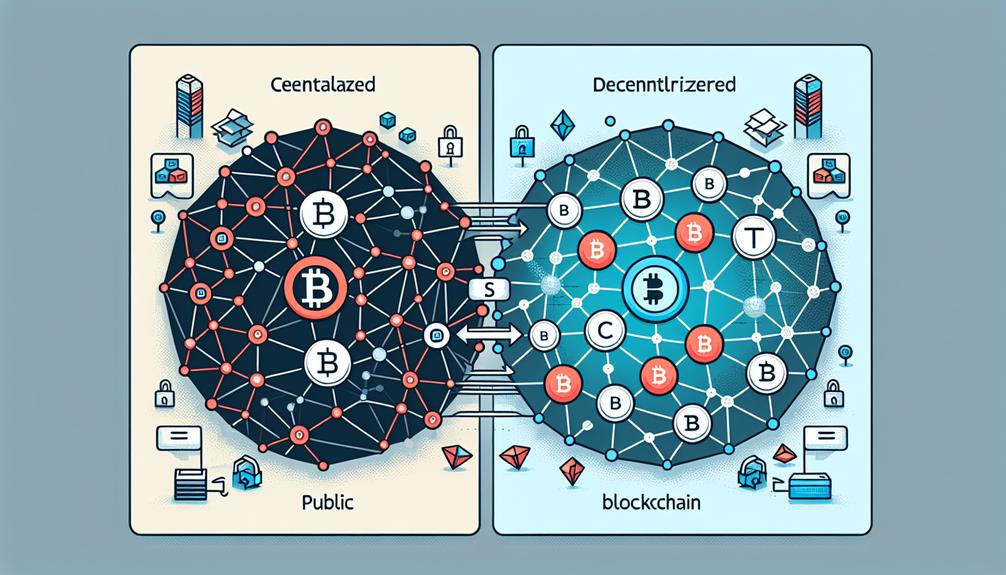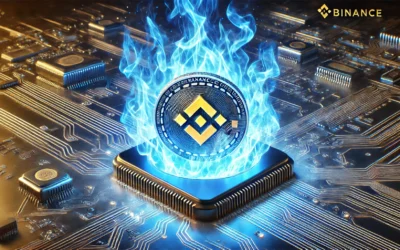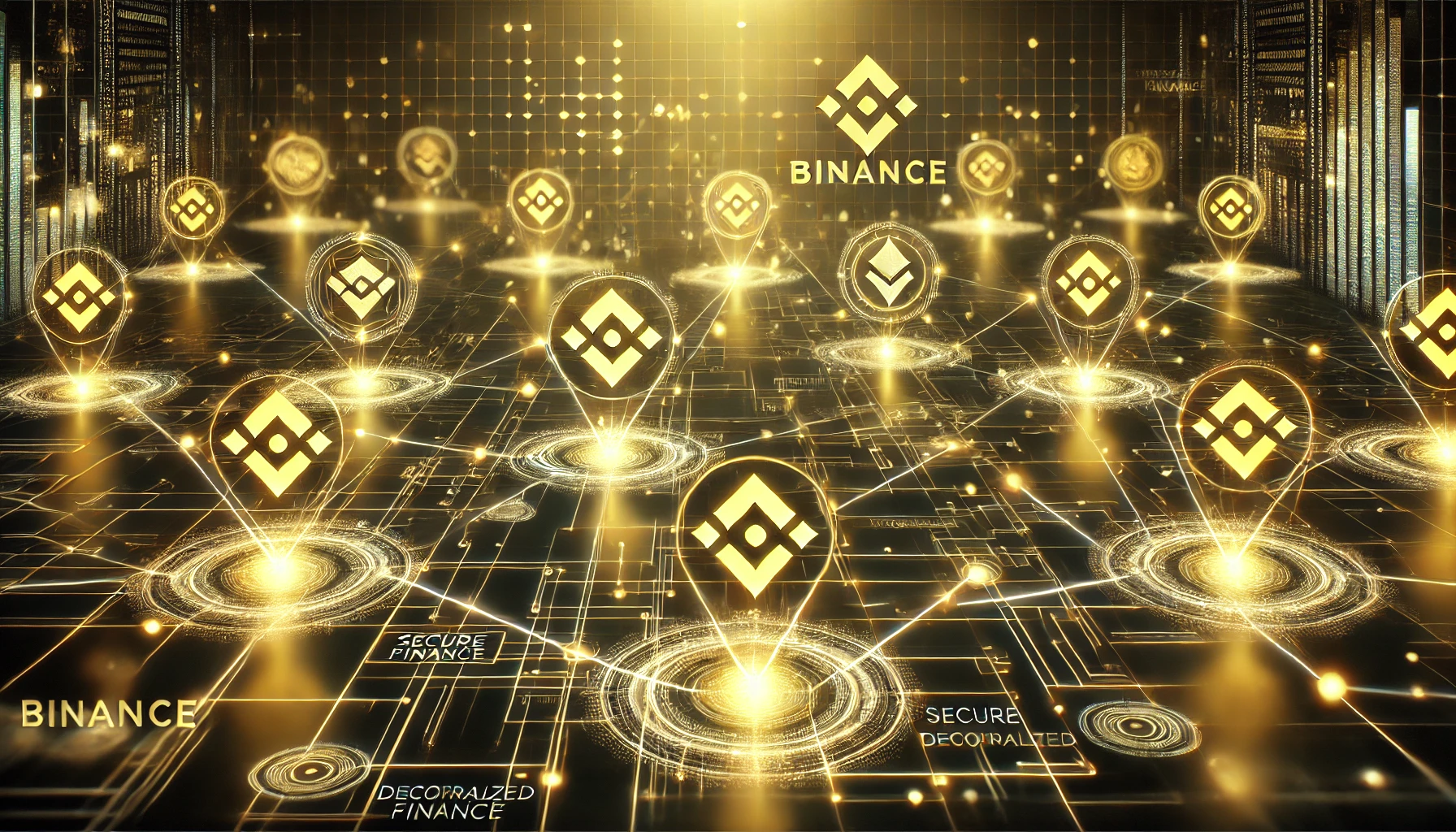All Blockchain Concepts
Understanding the Lightning Network for Bitcoin Scalability
To tackle Bitcoin's scalability issues, consider the Lightning Network. It's a second-layer solution that uses payment channels for quick, low-cost...
The Role of Nodes in Maintaining Blockchain Networks
In a blockchain network, you rely on nodes for transaction validation, ledger maintenance, and security enforcement. Full nodes store the entire blockchain...
The Role of Decentralized File Storage Systems in Blockchain
You're leveraging decentralized file storage systems in blockchain to bolster data redundancy, security, and accessibility through distributed nodes and...
How Does the Byzantine Fault Tolerance (Bft) Algorithm Work in Blockchain?
Byzantine Fault Tolerance (BFT) algorithms keep blockchain networks operational even when some nodes are faulty or malicious. With BFT, nodes reach consensus...
The Role of Merkle Trees in Blockchain Technology
In blockchain technology, Merkle trees safeguard data integrity and streamline transaction verification. You?ll notice that leaf nodes represent...
How Blockchain Oracles Connect Blockchains to External Data
Blockchain oracles are intermediaries that enable smart contracts to interact with off-chain data sources. They fetch and verify data from APIs or web...
How Distributed Ledger Technology (Dlt) Differs From Traditional Databases
Distributed Ledger Technology (DLT) and traditional databases differ significantly. In traditional databases, a central authority manages and controls access,...
The Technical Aspects of Tokenization on Blockchain Platforms
When tokenizing on blockchain platforms, you'll need to define the token's purpose, attributes, and adhere to standards like ERC-20. Write secure smart...
How Initial Coin Offerings (Icos) Work From a Technical Perspective
To understand ICOs from a technical perspective, start with a well-detailed whitepaper outlining the project's goals, technology, and tokenomics. Develop...
The Function of Smart Contracts in Blockchain Applications
Smart contracts in blockchain applications automate and secure transactions by executing pre-written code based on predefined conditions. You won't need...
What Is Hashing?
Hashing transforms input data into fixed-size strings using mathematical algorithms, ensuring determinism and irreversibility. It's vital for data...
What Are Nfts?
NFTs, or Non-Fungible Tokens, are cryptographic assets on blockchain networks, each with unique identifiers and immutable metadata ensuring their...
What Is Sha256?
SHA-256 is a cryptographic hash function from the SHA-2 family. It converts input data into a fixed 256-bit hash through sophisticated bitwise operations and...
What Is Cryptography?
Cryptography transforms your information into coded formats, ensuring confidentiality and data integrity. It uses mathematical algorithms for encryption,...
Exploring the Role of Consensus in Blockchain Governance
In blockchain governance, consensus mechanisms are essential for ensuring data integrity and security in decentralized networks. These algorithms, such as...
How Cryptographic Hashing Secures Blockchain Data
Cryptographic hashing secures blockchain data by generating unique, fixed-size hash values using algorithms like SHA-256. When block data is hashed, it...
Exploring the Use of Multi-Signature Wallets in Cryptocurrencies
Using multi-signature (multi-sig) wallets in cryptocurrencies offers robust security by requiring multiple private keys for transaction approval. This...
How Block Explorers Work and Their Importance in Blockchain
Using block explorers, you gain real-time visibility into blockchain networks, enabling you to track transactions, inspect wallet addresses, and verify data...
How Sidechains and Pegged Sidechains Work in Blockchain Technology
In blockchain technology, sidechains are parallel blockchains that operate alongside the main chain, enhancing scalability and performance. Assets are secured...
Understanding the Differences Between Private and Public Blockchains
To understand the differences between private and public blockchains, consider accessibility and participation. Public blockchains are open and decentralized,...
Understanding the Importance of Blockchain Interoperability
Understanding blockchain interoperability is crucial because it enables smooth communication across different blockchains, enhancing scalability and...
The Concept of Timestamping in Blockchain Technology
In blockchain technology, timestamping uses cryptographic methods to verify the integrity and order of data. Each block has a timestamp created through hash...
How Zk-Snarks (Zero-Knowledge Succinct Non-Interactive Arguments of Knowledge) Enhance Privacy in Blockchain
zk-SNARKs boost blockchain privacy by providing cryptographic proofs of knowledge without revealing the underlying data. You can validate transactions...
How Privacy Coins Maintain Anonymity in Transactions
Privacy coins keep your transactions anonymous through several advanced techniques. Coin mixing blends multiple transactions, obscuring the origin of funds....
What Is Decentralized Finance (Defi)?
Decentralized Finance (DeFi) revolutionizes financial services by using blockchain technology to create transparent and autonomous systems. Unlike traditional...
What Is a Public Key and Private Key?
A public key lets you encrypt data for secure exchange and can be shared openly without risk. A private key, however, must stay secret because it decrypts...
What Is Sharding?
Sharding divides a large dataset into smaller, self-contained units called shards. This technique partitions your database horizontally, spreading the load...
What Are the Different Types of Blockchain (Public, Private, Consortium)?
Blockchain comes in three types: public, private, and consortium. Public blockchains like Bitcoin and Ethereum are decentralized and permissionless, allowing...
What Are the Most Popular Blockchain Platforms?
The most popular blockchain platforms include Ethereum, Bitcoin, Binance Smart Chain, Cardano, and Polkadot. Ethereum excels in executing smart contracts with...
What Are the Benefits of Smart Contracts?
You gain significant benefits from using smart contracts. They automate execution based on predefined conditions, eliminating intermediaries and reducing...
How Can One Develop a Blockchain Application?
To develop a blockchain application, start by understanding blockchain basics, especially decentralized consensus. Choose a secure platform like Ethereum or...
What Are the Legal Challenges of Blockchain Technology?
Blockchain technology presents several legal challenges you need to navigate. Jurisdictional issues arise because blockchain operates globally, complicating...
How Are Governments Regulating Blockchain and Cryptocurrencies?
Governments are actively regulating blockchain and cryptocurrencies through thorough frameworks. You'll find licensing requirements essential for legal...
What Is the Future of Blockchain Technology?
You're about to see blockchain technology revolutionize various sectors by merging with AI and IoT for enhanced data security and automation. As...
How Will Blockchain Evolve in the Next Decade?
Over the next decade, blockchain adoption is set to soar, with 84% of companies already exploring its potential. You'll see sectors like...
What Emerging Trends Should We Watch in Blockchain Technology?
You should watch several key trends in blockchain technology. Decentralized Finance (DeFi) is rapidly optimizing financial services through yield farming and...
What Are the Main Challenges Facing Blockchain Technology?
You're facing considerable challenges when using blockchain technology. Scalability issues limit transaction throughput and network latency hampers...
What Are the Scalability Issues With Blockchain?
Blockchain scalability issues include limited transaction throughput, high latency, network congestion, and resource intensity. With its current design,...
How Can Blockchain Overcome Energy Consumption Concerns?
You can address blockchain's energy consumption concerns by using more efficient consensus mechanisms like Proof of Stake (PoS) instead of energy-intensive...
What Is a Crypto Launchpad?
A crypto launchpad is your gateway to discovering and investing in new, high-potential cryptocurrency projects before they hit the broader market. These...
What Is a Centralized Exchange?
A centralized exchange (CEX) is a platform where you buy, sell, and trade cryptocurrencies through an intermediary. These exchanges handle transactions by...
What Is the Ethereum Virtual Machine (Evm)?
The Ethereum Virtual Machine (EVM) is Ethereum's decentralized computing engine. It lets you run smart contracts and decentralized applications (dApps)...
What Is a Concensus Mechanism?
A consensus mechanism is a protocol that ensures all participants in a decentralized system agree on transaction validity. It builds trust without a central...
What Is a Decentralized Exchange?
A decentralized exchange (DEX) lets you trade cryptocurrencies directly with other users without relying on a central authority. You maintain full control...
What Is a Decentralized App (Dapp)?
A decentralized app (Dapp) is a type of application that runs on a blockchain network, giving control to users rather than a central authority. These apps use...
What Are Smart Contracts?
Smart contracts are self-executing contracts written in code that automatically enforce terms when predefined conditions are met. They operate autonomously on...
What Is the Markets in Crypto-Assets (Mica) Framework?
The Markets in Crypto-Assets (MiCA) Framework is a comprehensive regulatory approach for cryptocurrencies in the EU. Launched in September 2020, it aims to...
How Can Blockchains Scale?
To scale blockchains, it is important to optimize nodes for better transaction processing and properly incentivize validators. Sharding divides the network to...
What Are Hot and Cold Cryptocurrency Wallets?
Hot and cold cryptocurrency wallets serve different purposes in managing digital assets. Hot wallets are connected to the internet, making them perfect for...
What Is the Environmental Impact of Cryptocurrency?
Cryptocurrency mining has a substantial environmental impact, consuming vast amounts of electricity, often from non-renewable sources. This energy-intensive...
What Is Binance Coin Burning?
Binance Coin burning is a strategy Binance uses to reduce the total supply of BNB tokens. They periodically remove a portion of BNB from circulation by...
How Does Delegated Proof of Stake (Dpos) Differ From Traditional Pos?
Delegated Proof of Stake (DPoS) differs from traditional Proof of Stake (PoS) by involving the community more directly in the validation process. In DPoS, you...
What Is the Difference Between Staking and Yield Farming?
Staking and yield farming are two ways to earn rewards with cryptocurrency, but they work differently. When you stake, you lock up your crypto to support a...
What Is the Binance Chain?
Binance Chain is a lightning-fast blockchain built for decentralized trading and asset issuance. It addresses the limitations of centralized systems by...
What Is Staking?
Staking Meaning At its core, staking involves participating in a blockchain network by holding and locking up a certain amount of cryptocurrency. This action...
The Transformative Impact of Cryptocurrencies on the Global Economy
Intro In the digital age, cryptocurrencies have emerged as a beacon of innovation, challenging traditional financial paradigms and offering a glimpse into a...
Understanding the Basics of Blockchain Technology
How Blockchain Works Key Concepts: Blocks, Nodes, and Miners Blockchain is essentially a chain of blocks, but not in the traditional sense of those words....
Cryptocurrencies vs. Cryptotokens: Understanding the Key Differences
Cryptocurrencies: Digital Money Reinvented Cryptocurrencies are a revolutionary form of digital or virtual currency secured by cryptography, which is a method...




